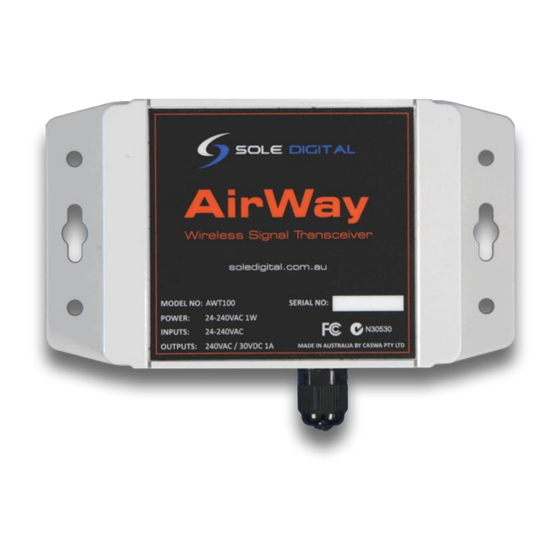
Summary of Contents for Sole Digital AirWay AWT100
- Page 1 AirWay Wireless Signal Transceiver Model AWT100, Version 1.0 Installation and User Manual V1.2: 28/08/2012 © CASWA Pty Ltd – 2012...
-
Page 2: Table Of Contents
CONTENTS OVERVIEW ..........................3 SPECIFICATIONS ........................4 2.1 Physical Specifications ......................4 2.2 Electrical Specifications ......................5 2.3 Communication Specifications ....................5 2.3.1 Communications Range ................... 5 INSTALLATION DETAILS ......................6 3.1 Prior to Installation ......................... 6 3.2 Wiring Diagrams ........................7 3.2.1 Connecting Two AirWay Units Communicating Together ........ -
Page 3: Overview
1 OVERVIEW AirWay is an electronic device that wirelessly transmits and receives up to 4 input/output control signals. It can be used to provide remote I/O for products such as CASWA’s Liftlog™ or Liftlog XL data logger, where the desired signals cannot be cabled into the logger directly. Alternatively, two AirWay units can be used together to provide up to 4 virtual connections. -
Page 4: Specifications
2 SPECIFICATIONS 2.1 Physical Specifications Overall length (mm): Overall width (mm): Overall height (mm): Weight (kg): Mounting 2 x 8.5mm screws OR 4 x 5mm screws Figure 1: Case Dimensions 4 | Page © CASWA Pty Ltd – 2012... -
Page 5: Electrical Specifications
2.2 Electrical Specifications Parameter Description Units Supply voltage Supply current Input pin voltage Max voltage for output relays V AC fault V DC Max current sink per output set point relay fault Note1 Allowable operating temperature °C Note1: Extended operation at maximum temperature will reduce the life the device. 2.3 Communication Specifications Communications between the device and a host is usually via a Bluetooth radio link. -
Page 6: Installation Details
3 INSTALLATION DETAILS 3.1 Prior to Installation Before installing your AirWay device visually inspect the device and check that the case is not damaged and fits together securely. Remove the cover by undoing the 4 screws on the rear of the device to access the circuit board and screwed terminals inside. -
Page 7: Wiring Diagrams
3.2 Wiring Diagrams 3.2.1 Connecting Two AirWay Units Communicating Together 1. 0V 2. 32-240VAC Output 4 Output 3 Existing Output 2 control circuit Output 1 11. Input 4 12. Input 3 13. Input 2 14. Input 1 Figure 3: Connecting up 2 AirWay units NB: Output pins (3-4, 5-6, 7-8 and 9-10) are Normally Open and rated for 250V AC/32VDC 4A. -
Page 8: Airway Providing Remote Inputs For A Liftlogxl
3.2.2 AirWay Providing Remote Inputs for a LiftlogXL AirWay can be used to provide remote inputs for other devices (e.g. Liftlog or LiftlogXL). Figure 4 provides the wiring details for using an AirWay to transmit the longitudinal travel motions from a LiftlogXL. -
Page 9: Implementing A Link Status Output
3.2.3 Implementing a Link Status Output By connecting one of the inputs to the supply voltage, the AirWay will send the assigned signal continuously once a connection is made. The receiving device can then determine when a link is active. 1. -
Page 10: Commissioning Details
4 COMMISSIONING DETAILS AirWay is designed to be commissioned using a laptop computer. You will need a CASWA LINK-2 Bluetooth Modem and the Field Service Utility (FSU) software application loaded on a laptop. 4.1 Installing and Launching the FSU Application 4.1.1 FSU Program Installation Ensure that your computer is switched on, connected to the internet and that the minimum required software versions are installed (see 0 for minimum system requirements). -
Page 11: Connecting To The Device
4.2 Connecting to the Device The FSU will scan for Bluetooth enabled devices. This process takes approximately 10 seconds, when complete a list of all CASWA devices within range will be displayed. If a particular AirWay unit is not found, ensure it is powered up and press <Look for devices>... -
Page 12: Airway General Configuration Screen
AirWay General Configuration Screen Once the firmware version has been verified, the following screen will appear. This screen shows the: AirWay ID The device it is bound to. Current firmware version operating on the device. The connected status of the AirWay being configured To enter/change the CraneID, type the desired name into the ID field. -
Page 13: Selecting The Input Signals
4.5.1 Selecting the Input Signals The input tab allows you to select what signals will be sent to the bound device when each of the AirWay inputs is activated. Additionally, currently active inputs are highlighted. Shown here are two example configurations, one that might be used when the AirWay being configured is bound to a second AirWay unit and a simple 1 to 1 mapping of inputs and outputs is... -
Page 14: Operating Behaviour
5 OPERATING BEHAVIOUR The AirWay is fitted with a multi-colour LED on the front panel that indicates connectivity. This has two modes: Green = Connected Red = Not Connected A connection usually takes about 5 seconds to initiate after power-up. 14 | Page ©... -
Page 15: Routine Maintenance
6 ROUTINE MAINTENANCE There is not routine maintenance for this device. 15 | Page © CASWA Pty Ltd – 2012... -
Page 16: Appendix A: Communication Protocol
APPENDIX A: COMMUNICATION PROTOCOL The host sends single character commands to the device to write or query parameters. Each command must be followed by a carriage return <CR>(ASCII 13). Where the command is a query command, no arguments are sent and the device will respond with a single line (except for the “u”... -
Page 17: Appendix B: Fsu System Requirements
APPENDIX B: FSU SYSTEM REQUIREMENTS The minimum requirements for operating CASWA’s Field Service Utility (FSU) and Link-2 Bluetooth modem are: Laptop computer running Windows XP SP3 or later; One Spare USB port; Microsoft .NET framework 3.5. 17 | Page ©...

Need help?
Do you have a question about the AirWay AWT100 and is the answer not in the manual?
Questions and answers